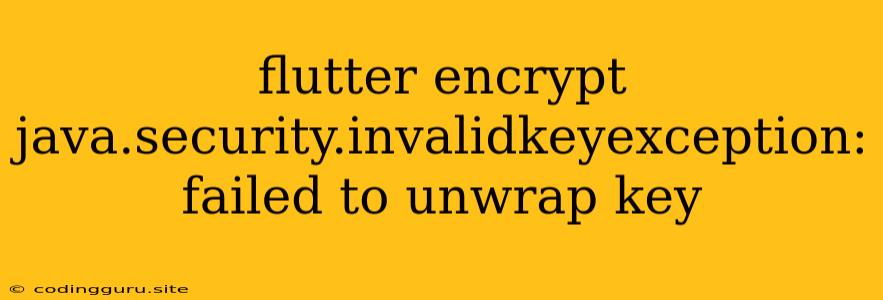Flutter Encrypt: Unraveling the java.security.InvalidKeyException: Failed to unwrap key Enigma
The java.security.InvalidKeyException: Failed to unwrap key error in Flutter is a common hurdle when working with encryption. This error often arises when attempting to decrypt data using a key that is not properly formatted or compatible with the decryption algorithm. Let's dive into the heart of this issue, exploring the common causes and effective troubleshooting strategies.
Understanding the Error
The java.security.InvalidKeyException indicates that the key you're using to decrypt data is not valid. In simpler terms, the key is either not in the expected format or doesn't match the algorithm used for encryption. This error can stem from a variety of factors, but here are the most common culprits:
- Key Format Mismatch: The key you're using might be in an incompatible format for the chosen encryption algorithm. Encryption algorithms have specific requirements for key formats (e.g., size, encoding).
- Incorrect Encryption Algorithm: The decryption algorithm used might be different from the one used for encryption.
- Key Corruption: The key itself might be corrupt or damaged.
- Key Generation Issues: The key generation process might have been faulty, leading to an invalid key.
Troubleshooting Steps
Tackling the java.security.InvalidKeyException requires a methodical approach. Here's a breakdown of the most effective troubleshooting steps:
1. Verify Key Format
- Double-check the Key Type: Ensure that the key you're using is of the appropriate type for the algorithm. Common key types include AES keys, RSA keys, and ECDSA keys.
- Examine Key Length: Confirm that the key length matches the expected length for the algorithm. For instance, AES-256 requires a 256-bit key.
- Verify Key Encoding: Check the key encoding. The key might need to be in a specific format (e.g., Base64, hexadecimal) for the algorithm to work correctly.
2. Review Encryption and Decryption Algorithms
- Confirm Algorithm Consistency: Ensure that the same encryption algorithm is used for both encryption and decryption. Inconsistency between algorithms will result in an invalid key exception.
3. Inspect Key Generation Process
- Debug Key Generation Logic: Carefully examine the code responsible for generating the encryption key. Ensure that the generation process is correct and adheres to the algorithm's requirements.
4. Inspect Key Storage and Retrieval
- Check Key Storage: Verify that the key is being stored and retrieved correctly. Any corruption in storage can render the key unusable.
- Secure Key Storage: Always prioritize secure key storage. Avoid storing keys in plain text. Implement secure storage solutions like encrypted databases or key management services.
5. Leverage Cryptographic Libraries
- Explore Cryptographic Libraries: Utilize established cryptographic libraries like
cryptofor secure key management and encryption in Flutter. These libraries offer pre-built functionality and help streamline the encryption process.
Example: Secure Key Storage
import 'package:encrypt/encrypt.dart';
void main() {
// Generate a secure key
final key = Key.fromSecureRandom(32); // 256-bit key for AES-256
// Encrypt some data
final encrypter = Encrypter(AES(key));
final encrypted = encrypter.encrypt("My Secret Message");
// Store the encrypted data and the key securely
// ... (e.g., in a database, secure storage, or using a key management service)
// Later, to decrypt the data:
// Retrieve the key securely
// ... (load the key from the storage)
// Decrypt the data
final decrypter = Encrypter(AES(key));
final decrypted = decrypter.decrypt(encrypted);
}
Example: Verifying Key Length and Encoding
import 'package:crypto/crypto.dart';
import 'dart:convert';
void main() {
// Example Key
final keyString = "your_key_string";
final key = utf8.encode(keyString);
// Check Key Length
if (key.length != 32) { // For AES-256
throw Exception("Invalid key length. AES-256 requires a 32-byte key.");
}
// Encode the Key (Example: Base64)
final encodedKey = base64Encode(key);
}
Key Takeaways
- Cryptographic best practices are essential: Prioritize secure key generation, storage, and handling.
- Utilize reliable libraries: Leverage established cryptographic libraries for simplified encryption and decryption.
- Don't store keys in plain text: Implement secure storage mechanisms.
- Thorough debugging is crucial: Systematically analyze your code and key management practices.
Conclusion
Encountering the java.security.InvalidKeyException in Flutter is a common occurrence, but understanding the underlying causes and applying the right troubleshooting techniques allows for smooth sailing. By diligently inspecting key formats, algorithms, storage methods, and leveraging secure cryptographic libraries, you can effectively overcome this error and ensure the integrity of your encrypted data.
